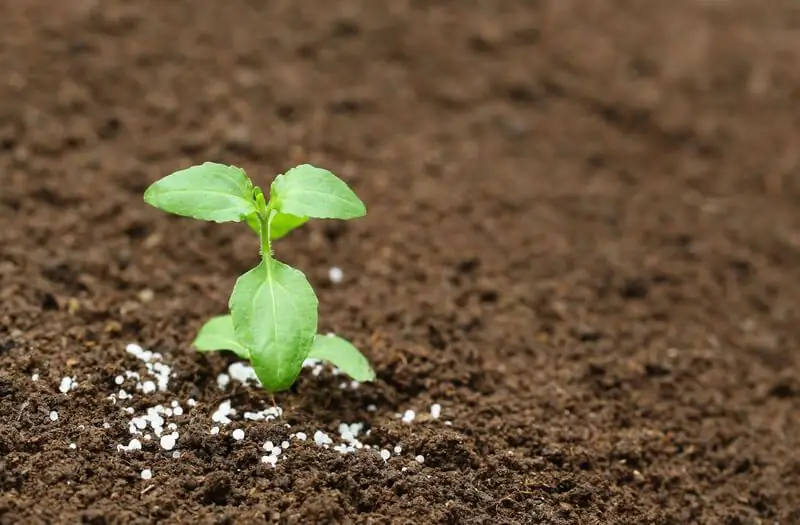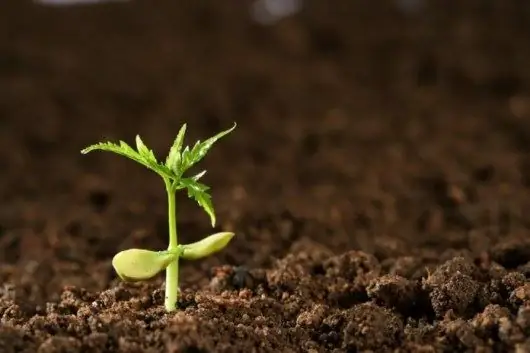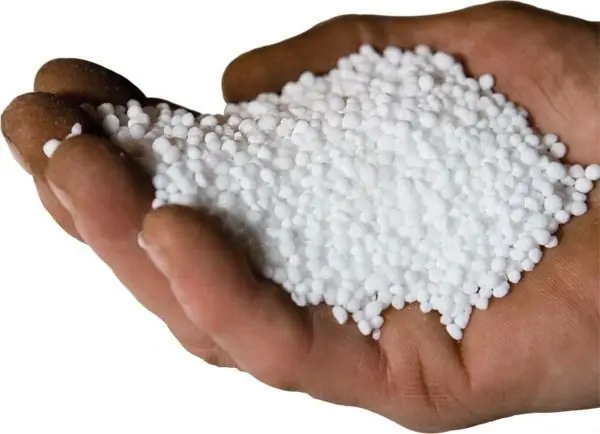For the normal functioning of any living being requires oxygen, carbon, hydrogen and nitrogen. The last chemical element is necessary for both human life and plants. To replenish its content, special nitrogen fertilizers are used, which will be discussed later.
Bait containing nitrate

What do you need to know about them? The main source of nitrogen for plants is the soil. Depending on its type and degree of wear, the amount of fertilizer is determined. Usually, crops feel a lack of nitrogen in sandy and sandy soils. It is these soils that always require additional enrichment with various fertilizers. In this case, the plants will feel normal.
How is nitrogen fertilizer applied correctly? Studies have shown that most of them are contained in humus. The thicker its layer, the greater the amount of nitrogen. Thus, plants in such soil feel much better.
Humus is a persistent slowly decomposing substance. This means that the selectionminerals from it is also carried out gradually. Thus, in the presence of a thick layer of humus, plants require less additional feeding.
Why do plants need nutrition?

Experienced flower growers recommend using nitrogen mineral fertilizers for growing various crops. But what are they for? As you know, nitrogen is not found in all organic compounds. It is not found in fiber, starch, sugars or oils.
Nitrogen is present in protein and amino acids. Moreover, it is an important component of the nucleic acid, which is found in all cells responsible for the duplication of hereditary information and protein synthesis.
Nitrogen is also present in chlorophyll. As you know, this substance contributes to the absorption of solar energy by plants. Fertilizer is also found in various components of organic media, such as lipoids, alkaloids and similar substances.
The aerial parts of plants contain nitrogen. Most of this element in young leaf plates. When the flowering process is completed, nitrogen passes to the reproductive organs of the plant and accumulates there. During the period of seed formation, nitrogen is withdrawn from the vegetative organs in the maximum amount. As a result, they are severely emaciated. However, if the soil contains an excessive amount of s altpeter, it will be distributed to all organs of the plant. As a result, there will be a rapid growth of aboveground mass, a delay in fruit ripening and a decrease in yield.
ToTo guarantee a good harvest, it is necessary to apply nitrogen fertilizers in reasonable quantities. If plants consume the element in question in sufficient quantities, they will be able to fully develop and form leaves. With a lack of nitrogen, low yields and rapid wilting are observed.
Varieties
Nitrogen fertilizer is a substance that contains nitrate compounds.
Below are the main groups of this type of fertilizer:
- nitrate (sodium and calcium nitrate);
- ammonium (ammonium sulfate, ammonium chloride);
- ammonium nitrate fertilizers (ammonium nitrate);
- liquid nitrogen substances (anhydrous ammonia, ammonia water);
- amide fertilizers (urea).
The production of nitrogen fertilizers is usually carried out at large enterprises. Let us examine in more detail each of the listed types.
Nitrate fertilizers

This type of nutrient includes calcium nitrate. It looks like white granules, which contain 18% nitrogen. This fertilizer is suitable for soil with a high level of acidity. To improve the quality of the soil, it is necessary to systematically introduce calcium nitrate into it every year. It is highly soluble in water. Store fertilizer in sealed bags or bags.
Don't mix calcium nitrate with phosphate fertilizers.
The sodium mixture is characterized by 17% nitrogen content. The fertilizer dissolves well in water and is perfectly absorbed.plant roots. It is suitable for various cultures. Sodium nitrate is not recommended for use in autumn.
Ammonium fertilizers
This group includes ammonium sulfate. In appearance, it resembles a white powder with a nitrogen content of 20%. It can be used both as a main and as an additional feeding. Experts recommend applying this fertilizer in the fall, since the nitrogen in it is not washed off by groundwater and is fixed in the soil. If every year ammonium sulfate is introduced into the soil, then its acidification will gradually occur. Therefore, fertilizer must be mixed with chalk or lime in a ratio of 1:2.
There are no special problems with the storage of ammonium sulfate, since it is not hygroscopic. It is enough just to remember that alkaline substances cannot be used with it. Nitrogen fertilizer plants today produce ready mixes that are easy enough to apply to the soil.
Ammonium chloride in appearance is a yellow-white powder with a nitrate content of 26%. When this powder is applied to the soil, no leaching is observed. It is easy enough to store. For a long time, the powder does not cake and does not require grinding.
The main disadvantage of this fertilizer is chlorine. When 10 kg of nitrogen is introduced into the soil, twice as much gets into the soil. This element is poisonous for most plants. Ammonium chloride should be applied only in autumn. This will deactivate the chlorine it contains.
Ammonia nitrate fertilizers

SoWhat do you need to know about these elements? When it comes to nitrogen fertilizers for plants, ammonium nitrate immediately comes to mind. In appearance, this fertilizer looks like a whitish granular powder. The nitrogen content in it is 36%. Ammonium nitrate can be used both as a main fertilizer and as an additional top dressing.
The composition refers to non-ballast substances. It is mainly used in regions with a shortage of fluid. In soils with excess moisture, the use of nitrogen fertilizers of this type will be pointless, since the main active ingredient will be washed into groundwater.
Because ammonium nitrate is highly hygroscopic, it cannot be stored in damp areas. There it quickly caking and hardening. This does not mean at all that the composition will become unusable. Just before applying to the soil, it will need to be crushed, which can sometimes be quite problematic.
If you want to make your own nitrogen-phosphorus fertilizer by adding superphosphate to ammonium nitrate, then you will need to add any neutralizing component. You can use chalk, dolomite flour or lime for this purpose.
Amide elements
One of the most effective fertilizers of this group is urea or urea. They look like white granules. A characteristic feature of this fertilizer is the ability to acidify the soil. Urea can only be used in combination with neutralizing agents. It is rarely used as a main fertilizer. Urea mainly plays a rolefoliar feeding. It does not burn the leaves and is perfectly absorbed by plants.
Liquid nitrogen fertilizers

Ammonia water or ammonium hydroxide is actually ammonia dissolved in water. To distribute this fertilizer, a special technique is used, which allows it to be placed in the soil at a depth of 14-16 cm. The main advantage of liquid nitrogen fertilizers is low cost and easy digestibility. However, storing and transporting them is quite difficult. If fertilizer gets on the surface of the leaf, there is a high probability of burns.
Organic Nitrogen Components
What makes them special? Nitrogen is known to be present in organic compounds, but there is not much of it. Most nitrate is found in compost, consisting of leaf litter, lake silt, lowland peat and weeds. However, it is not recommended to use such a fertilizer as the main one. This can be fraught with nitrogen starvation of plants. Plus, such fertilizers strongly acidify the soil.
For which crops is the element in question important?

Nitrogen fertilizers are required for any fruit plants. However, application rates for different crops may vary.
It is possible to conditionally divide all plants according to the need for nitrogen into several categories:
- Plants that need a nitrate supplement to activate growth and development before planting in the ground. These include cabbage, potatoes, eggplant,zucchini, rhubarb, pumpkin, plum, cherry and berries. Approximately 26-28 g of nitrogen should be distributed per square meter of soil.
- Crops that need the nutrient in smaller quantities. These are cucumber, carrots, parsley, garlic, beets. In terms of square meter of area, only 18-19 grams of nitrogen will be enough for these vegetables for normal growth.
- Plants that need nitrate in moderation. Only 10-12 grams of nitrogen will be enough for them per square meter of area. Flower crops belong to this category: primroses, daisies, saxifrage.
How to use fertilizers correctly?
Let's dwell on this issue in more detail. To correctly calculate the required amount of nitrogen, it is worth considering factors such as soil type, season, climatic conditions and plant species. If you plan to cultivate soils with high acidity, then you can use nitrogen-potassium fertilizers. They will begin to be better absorbed, and the soil will have an optimal level of acidity.
If you live in steppe areas characterized by dry soil, it is important to fertilize periodically. Don't take sudden breaks. If nitrogen-phosphorus-potassium fertilizer is applied to the soil in a timely manner, you can get an excellent harvest.
The best time to apply them is 11-12 days after the snow melts. For the first feeding, urea is suitable. When the plants enter the active stage of vegetation, ammonium nitrate can be used.
Harm and benefit
In some cases, the use of nitrogenfertilizer harms plants. This is usually due to excess nitrate. The green mass of crops begins to grow too actively. As a result, shoots and leaf blades become thicker and larger. In this case, flowering is too short and weak, or does not occur at all. This means that the ovaries and fruits are not formed.
Burns may occur when the aerial parts of plants are treated with nitrogen fertilizers. In severe cases, the foliage dies off completely. It is for this reason that it is necessary to strictly adhere to the dosages indicated in the instructions for use.
Conclusion

In this review, we examined in detail what nitrogen fertilizers are. How to correctly determine their dosage and apply to the soil. Guided by the recommendations presented, you can easily get a good harvest on your site.






